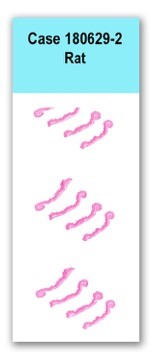Case 2 180629-2 (18BANN1427)
Conference Coordinator: Dr Sarah Stevens.
//
Mouse of uknown age.
Not available.
The only significant lesion was generalized scaling of the skin.
This slide has sections of haired skin extending from the epidermis to the panniculus. The superficial to middle portions of the dermis are infiltrated by small numbers of neutrophils and eosinophils with fewer lymphocytes, plasma cells and histiocytes, which occasionally form small, loose aggregates along the dermo-epidermal junction. The epidermis is moderately acanthotic, hyperkeratotic and overlain with a crust composed of compact, lamellar keratin, sloughed keratinocytes, fragments of hair shafts, and small aggregates of degenerate neutrophils.
Bacterial culture resulted in a pure growth of Staphylococcus xylosus.
Haired skin: mild to moderate, chronic, multifocal, neutrophilic and eosinophilic dermatitis with hyperkeratosis, moderate acanthosis and rare intracorneal pustules.
This case of dermatitis with prominent acanthosis and hyperkeratosis was caused by Staphylococcus xylosus. Conference discussion focused on differences between S. xylosus and Corynebacterium bovis, another cause of scaling dermatitis in mice. Grossly, these two etiologies can create similar lesions, however, histologically, S. xylosus tends to be associated with increased inflammation, epidermal necrosis or ulceration and pustule formation, while C. bovis lesions have minimal inflammation.
We thank Dr. Denise Imai-Leonard for contributing this case.Russo M, Invernizzi A, Gobbi A, and Radaelli E. “Diffuse scaling dermatitis in an athymic nude mouse.” Veterinary Pathology.2012. 50(4):722-726.

